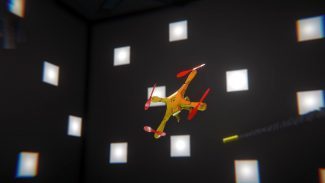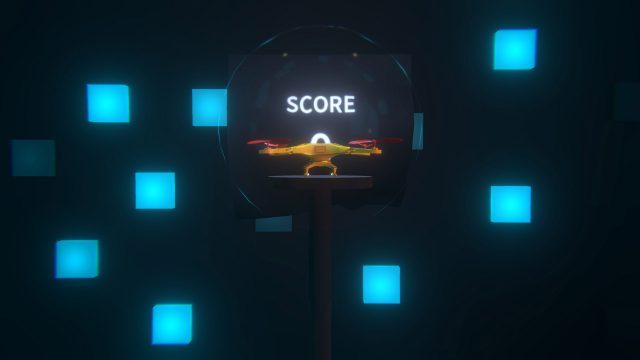With an intuitive control scheme and accessible gameplay, this simple and satisfying VR action game for HTC Vive and Oculus Rift and Touch turns out to be an excellent showcase of the fundamental benefits of using VR hardware for gaming. Drone Hero recently launched on Steam Early Access.

The objective of Drone Hero is to fly a small, highly maneuverable drone towards floating blue orbs that spawn in different positions around a room, which is loaded with obstacles and threats that become increasingly more challenging you progress. Collecting the orbs in the shortest time results in more points, and your final score needs to be high enough to earn one star (out of a possible three), unlocking the next level. The game is played as if you are standing in the room controlling the drone remotely, with the control system making use of a single motion controller: the drone mimics the tilt of the controller to change direction, and the trigger functions as the ‘thrust’ for the blades, which determines your speed and height.

Having clumsily flown a couple of real drones before, I can safely say that the flight model in Drone Hero is very forgiving; this isn’t a title for those looking for a drone simulation. However, the movement is natural and enjoyable, with an intuitive sense of inertia, and should make you feel like the world’s most-skilled drone pilot in about 20 minutes. It seems well-judged for the kind of gameplay involved; accessible from the start while being precise enough to require time and skill to master. Gamepad support is being considered, as some might want a system closer to that of a real drone controller, but the game already works well due to the tight correlation between the tilt of a motion controller and the drone.
Launching directly into a basic tutorial, the game first offers a much-needed epilepsy warning, as the virtual play room, which has the sticky ambience of a well-used disco, is covered in lights which pulse and change colour aggressively in time with the music’s appropriately ‘phat’ beats as well as reacting to drone impacts. The game makes effective use of light and dark, taking advantage of the deep contrast of the Vive and Rift’s OLED displays, resulting in a surprisingly atmospheric presentation.

Developer Jonas Johansson, the (currently) one-man team behind VR studio Neuston explained to me that the drone gameplay was a result of searching for a use of VR’s inherent spatial awareness. “I was working on a few prototypes, looking to find something that made good use of the incredible depth perception VR delivers—that sense of knowing exactly where something is [in 3D space]. Then I started thinking about drones”, he says. “I’ve always been fascinated by them. The way they just ‘sit’ there, in the middle of the air, with great precision—it’s really cool!”
Indeed, the importance of depth perception was the very first thing that struck me about the game—this would not play anywhere near as intuitively on a traditional screen. Being able to naturally gauge how far away the drone is relative to the orbs and obstacles is essential to the gameplay, and it is an excellent showcase of VR’s strengths.
The positive use of VR technology extends to the incorporation of HRTF-based binaural rendering via Steam Audio, and having a buzzing drone under your precise control means that the spatial audio has a discernible gameplay benefit. Flying the drone closely around your head (and at different heights and distances) produces a remarkably convincing effect; the audio adds to the strong visual depth perception and no doubt has an impact on your overall awareness and control.
The drone noises are complemented by an original soundtrack, which is thumping and energetic, but unlikely to suit everyone’s tastes. It seems to cycle through only three different tracks as the levels progress; a little more variety would be welcome here, or better still, the option for users to add their own playlists, while maintaining the audio-reactive lighting. As the title is still in Early Access, we hope the developer will take this into consideration.
During the Early Access period—which the developer estimates will take 6 to 12 months— some additional variety in the levels wouldn’t go amiss, although the game does manage to stay fresh throughout the 25 currently available. The learning curve is largely smooth aside from the odd difficulty spike at level 8, and the final few levels are suitably challenging to achieve one star, let alone three.
The game can be fully unlocked in a single session if you’re quick to master the controls, but those final few stars might take a lot of practice. Additional levels or a new mode would be appreciated, and an online leaderboard would help to entice players to keep returning for another go, and perhaps a multiplayer component could work well. Johansson has some plans but isn’t ready to confirm the details just yet.
“I want to connect players with each other to collaborate, compete and share”, he says. “There are a few social features in development and I’ll soon reveal more.”






